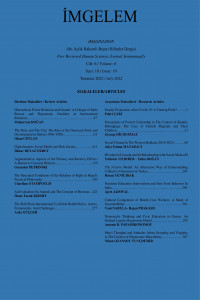Öz
The contemporary world is marked by deep collective discontent that is difficult to define. Various theories have been put forward to explain collective discontent. One of them is Davies's J-curve model. According to this model, collective discontent is most likely to occur when a prolonged period of economic and social development is followed by a short period of sharp reversal. The present study aims to explain widespread and deepening collective discontent in Turkey with the J-curve model by associating it with the social and political conditions of the country. The data used in the study were obtained from the Turkish Statistical Institute. In the present study, data on gross national income per capita, cost of living, number of suicides, and unemployment rates between 2002 and 2021 were analyzed. All data clearly show that the period of 2002-2021 is graphically compatible with the J-curve. Accordingly, significant economic and social progress took place in Turkey between 2002 and 2012/2013. Since 2012/2013, this progress left its place to regression. The J-curve model has only been studied in an industrial context in Turkey. This study is the first to evaluate the J-curve model in relation to social and political events.
Anahtar Kelimeler
Kaynakça
- Abeles, R. P. (1976). Relative Deprivation, Rising Expectations, and Black Militancy, Journal of Social Issues, 32(2), 119–137.
- Akbostanci, E. (2004). Dynamics of the Trade Balance: The Turkish J-Curve, Emerging Markets Finance & Trade, 40(5), 57–73.
- Akkoyunlu, K., & Öktem, K. (2016). Existential insecurity and the making of a weak authoritarian regime in Turkey, Southeast European and Black Sea Studies, 16(4), 505–527.
- Bahmani-Oskooee, M., & Ratha, A. (2004). The J-Curve: a literature review, Applied Economics, 36(13), 1377–1398.
- Bahmani‐Oskooee, M., Bose, N., & Zhang, Y. (2019). An asymmetric analysis of the J-curve effect in the commodity trade between China and the US, The World Economy, 42(10), 2854–2899.
- Bahmani-Oskooee, M., & Nasir, M. A. (2020). Asymmetric J-curve: evidence from industry trade between U.S. and U.K, Applied Economics, 52(25), 2679–2693.
- Berkowitz, L. (1968). The Study of Urban Violence: Some Implications of Laboratory Studies of Frustration and Aggression, American Behavioral Scientist, 11(4), 14–17.
- Calvert, P. (1970). Revolution, London: Pall Mall Press.
- Cohan, A. S. (1975). Theories of Revolution: An Introduction, New York: A Halsted Press Book.
- Davies, J. C. (1962). Toward a Theory of Revolution, American Sociological Review, 27(1), 5–19.
- de Gaay Fortman, B. (2005). Violence among peoples in the light of human frustration and aggression, European Journal of Pharmacology, 526(1), 2–8.
- de Tocqueville, A. (2011). The Ancien Régime and the French Revolution (A. Goldhammer (trans), Cambridge: Cambridge University Press.
- Durmaz, N. (2015). Industry level J-curve in Turkey, Journal of Economic Studies, 42(4), 689–706.
- Eligür, B. (2010). The Mobilization of Political Islam in Turkey, Cambridge: Cambridge University Press.
- Feierabend, I. K., & Feierabend, R. L. (1966). Aggressive Behaviors within Polities, 1948-1962: A Cross-National Study, The Journal of Conflict Resolution, 10(3), 249–271.
- Geschwender, J. A. (1964). Social Structure and the Negro Revolt: An Examination of Some Hypotheses, Social Forces, 43(2), 248–256.
- Gurr, T. R. (1968a). A Causal Model of Civil Strife: A Comparative Analysis Using New Indices, The American Political Science Review, 62(4), 1104–1124.
- Gurr, T. R. (1968b). Psychological Factors in Civil Violence, World Politics, 20(2), 245–278.
- Gurr, T. R. (1970a). Sources of Rebellion in Western Societies: Some Quantitative Evidence, The Annals of the American Academy of Political and Social Science, 391, 128–144.
- Gurr, T. R. (1970b). Why Men Rebel, New Jersey: Princeton University Press.
- Gurr, T. R., Peter, N. G., & Hula, R. C. (1976). Rogues, rebels, and reformes: a political history of urban crime and conflict, Beverly Hills, CA: Sage Publications.
- Halicioglu, F. (2008a). The bilateral J-curve: Turkey versus her 13 trading partners, Journal of Asian Economics, 19(3), 236–243.
- Halicioglu, F. (2008b). The J-curve dynamics of Turkey: an application of ARDL model, Applied Economics, 40(18), 2423–2429.
- Kaygusuz, Ö. (2018). Authoritarian Neoliberalism and Regime Security in Turkey: Moving to an ‘Exceptional State’ under AKP, South European Society and Politics, 23(2), 281–302.
- Kimmel, M. S. (1990). Revolution: A Sociological Interpretation, Cambridge: Polity Press.
- Kyophilavong, P., Shahbaz, M., & Uddin, G. S. (2013). Does J-curve phenomenon exist in case of Laos? An ARDL approach, Economic Modelling, 35, 833–839.
- Lal, A. K., & Lowinger, T. C. (2002). The J-Curve: Evidence from East Asia, Journal of Economic Integration, 17(2), 397–415.
- Miller, A. H., Bolce, L. H., & Halligan, M. (1977). The J-Curve Theory and the Black Urban Riots: An Empirical Test of Progressive Relative Deprivation Theory, The American Political Science Review, 71(3), 964–982.
- Nusair, S. A. (2017). The J-Curve phenomenon in European transition economies: A nonlinear ARDL approach, International Review of Applied Economics, 31(1), 1–27.
- Öniş, Z. (2015). Monopolising the Centre: The AKP and the Uncertain Path of Turkish Democracy, The International Spectator, 50(2), 22–41.
- Özsoy Boyunsuz, Ş. (2016). The AKP’S proposal for a “Turkish type of presidentialism” in comparative context, Turkish Studies, 17(1), 68–90.
- Pettee, G. S. (1938). The Process of Revolution, New York: Harper & brothers.
- Şen, M. (2010). Transformation of Turkish Islamism and the Rise of the Justice and Development Party, Turkish Studies, 11(1), 59–84.
- Tanter, R., & Midlarsky, M. (1967). A Theory of Revolution, The Journal of Conflict Resolution, 11(3), 264–280.
- Tuğal, C. (2009). Passive Revolution: Absorbing the Islamic Challenge to Capitalism, Stanford, California: Stanford University Press.
- Turam, B. (2007). Between Islam and the State, Stanford, California: Stanford University Press.
Öz
The contemporary world is marked by deep collective discontent that is difficult to define. Various theories have been put forward to explain collective discontent. One of them is Davies's J-curve model. According to this model, collective discontent is most likely to occur when a prolonged period of economic and social development is followed by a short period of sharp reversal. The present study aims to explain widespread and deepening collective discontent in Turkey with the J-curve model by associating it with the social and political conditions of the country. The data used in the study were obtained from the Turkish Statistical Institute. In the present study, data on gross national income per capita, cost of living, number of suicides, and unemployment rates between 2002 and 2021 were analyzed. All data clearly show that the period of 2002-2021 is graphically compatible with the J-curve. Accordingly, significant economic and social progress took place in Turkey between 2002 and 2012/2013. Since 2012/2013, this progress left its place to regression. The J-curve model has only been studied in an industrial context in Turkey. This study is the first to evaluate the J-curve model in relation to social and political events.
Anahtar Kelimeler
Kaynakça
- Abeles, R. P. (1976). Relative Deprivation, Rising Expectations, and Black Militancy, Journal of Social Issues, 32(2), 119–137.
- Akbostanci, E. (2004). Dynamics of the Trade Balance: The Turkish J-Curve, Emerging Markets Finance & Trade, 40(5), 57–73.
- Akkoyunlu, K., & Öktem, K. (2016). Existential insecurity and the making of a weak authoritarian regime in Turkey, Southeast European and Black Sea Studies, 16(4), 505–527.
- Bahmani-Oskooee, M., & Ratha, A. (2004). The J-Curve: a literature review, Applied Economics, 36(13), 1377–1398.
- Bahmani‐Oskooee, M., Bose, N., & Zhang, Y. (2019). An asymmetric analysis of the J-curve effect in the commodity trade between China and the US, The World Economy, 42(10), 2854–2899.
- Bahmani-Oskooee, M., & Nasir, M. A. (2020). Asymmetric J-curve: evidence from industry trade between U.S. and U.K, Applied Economics, 52(25), 2679–2693.
- Berkowitz, L. (1968). The Study of Urban Violence: Some Implications of Laboratory Studies of Frustration and Aggression, American Behavioral Scientist, 11(4), 14–17.
- Calvert, P. (1970). Revolution, London: Pall Mall Press.
- Cohan, A. S. (1975). Theories of Revolution: An Introduction, New York: A Halsted Press Book.
- Davies, J. C. (1962). Toward a Theory of Revolution, American Sociological Review, 27(1), 5–19.
- de Gaay Fortman, B. (2005). Violence among peoples in the light of human frustration and aggression, European Journal of Pharmacology, 526(1), 2–8.
- de Tocqueville, A. (2011). The Ancien Régime and the French Revolution (A. Goldhammer (trans), Cambridge: Cambridge University Press.
- Durmaz, N. (2015). Industry level J-curve in Turkey, Journal of Economic Studies, 42(4), 689–706.
- Eligür, B. (2010). The Mobilization of Political Islam in Turkey, Cambridge: Cambridge University Press.
- Feierabend, I. K., & Feierabend, R. L. (1966). Aggressive Behaviors within Polities, 1948-1962: A Cross-National Study, The Journal of Conflict Resolution, 10(3), 249–271.
- Geschwender, J. A. (1964). Social Structure and the Negro Revolt: An Examination of Some Hypotheses, Social Forces, 43(2), 248–256.
- Gurr, T. R. (1968a). A Causal Model of Civil Strife: A Comparative Analysis Using New Indices, The American Political Science Review, 62(4), 1104–1124.
- Gurr, T. R. (1968b). Psychological Factors in Civil Violence, World Politics, 20(2), 245–278.
- Gurr, T. R. (1970a). Sources of Rebellion in Western Societies: Some Quantitative Evidence, The Annals of the American Academy of Political and Social Science, 391, 128–144.
- Gurr, T. R. (1970b). Why Men Rebel, New Jersey: Princeton University Press.
- Gurr, T. R., Peter, N. G., & Hula, R. C. (1976). Rogues, rebels, and reformes: a political history of urban crime and conflict, Beverly Hills, CA: Sage Publications.
- Halicioglu, F. (2008a). The bilateral J-curve: Turkey versus her 13 trading partners, Journal of Asian Economics, 19(3), 236–243.
- Halicioglu, F. (2008b). The J-curve dynamics of Turkey: an application of ARDL model, Applied Economics, 40(18), 2423–2429.
- Kaygusuz, Ö. (2018). Authoritarian Neoliberalism and Regime Security in Turkey: Moving to an ‘Exceptional State’ under AKP, South European Society and Politics, 23(2), 281–302.
- Kimmel, M. S. (1990). Revolution: A Sociological Interpretation, Cambridge: Polity Press.
- Kyophilavong, P., Shahbaz, M., & Uddin, G. S. (2013). Does J-curve phenomenon exist in case of Laos? An ARDL approach, Economic Modelling, 35, 833–839.
- Lal, A. K., & Lowinger, T. C. (2002). The J-Curve: Evidence from East Asia, Journal of Economic Integration, 17(2), 397–415.
- Miller, A. H., Bolce, L. H., & Halligan, M. (1977). The J-Curve Theory and the Black Urban Riots: An Empirical Test of Progressive Relative Deprivation Theory, The American Political Science Review, 71(3), 964–982.
- Nusair, S. A. (2017). The J-Curve phenomenon in European transition economies: A nonlinear ARDL approach, International Review of Applied Economics, 31(1), 1–27.
- Öniş, Z. (2015). Monopolising the Centre: The AKP and the Uncertain Path of Turkish Democracy, The International Spectator, 50(2), 22–41.
- Özsoy Boyunsuz, Ş. (2016). The AKP’S proposal for a “Turkish type of presidentialism” in comparative context, Turkish Studies, 17(1), 68–90.
- Pettee, G. S. (1938). The Process of Revolution, New York: Harper & brothers.
- Şen, M. (2010). Transformation of Turkish Islamism and the Rise of the Justice and Development Party, Turkish Studies, 11(1), 59–84.
- Tanter, R., & Midlarsky, M. (1967). A Theory of Revolution, The Journal of Conflict Resolution, 11(3), 264–280.
- Tuğal, C. (2009). Passive Revolution: Absorbing the Islamic Challenge to Capitalism, Stanford, California: Stanford University Press.
- Turam, B. (2007). Between Islam and the State, Stanford, California: Stanford University Press.
Ayrıntılar
| Birincil Dil | İngilizce |
|---|---|
| Konular | Sosyoloji |
| Bölüm | Makaleler |
| Yazarlar | |
| Yayımlanma Tarihi | 15 Temmuz 2022 |
| Gönderilme Tarihi | 10 Şubat 2022 |
| Kabul Tarihi | 11 Mart 2022 |
| Yayımlandığı Sayı | Yıl 2022 Cilt: 6 Sayı: 10 |
Cited By
WHO FEELS MORE DEPRIVED: THE EFFECT OF AGE AND EDUCATION ON PERCEPTION OF DEPRIVATION
Nişantaşı Üniversitesi Sosyal Bilimler Dergisi
https://doi.org/10.52122/nisantasisbd.1160432

This work licensed under a Creative Commons Attribution-NonCommercial 4.0 International License.
Please click here to contact the publisher.


